Numerical Study and Experimental Validation of Deformation of <111> FCC CuAl Single Crystal Obtained by Additive Manufacturing
Abstract
1. Introduction
2. Model and Experimental Conditions
3. Results of Simulation and Comparison with Experiment
3.1. Beginning of Plastic Deformation
3.2. Deformation Relief
3.3. Evolution of Dislocation Structure
3.3.1. The Structure of Low-Mobility Dislocation Complexes
3.3.2. Stable Dislocation Configuration—Stacking Fault Tetrahedron
4. Discussion of the Relationship between the Structural Changes and the Stress–Strain Curve Behavior
5. Conclusions
Author Contributions
Funding
Institutional Review Board Statement
Informed Consent Statement
Data Availability Statement
Conflicts of Interest
References
- Khoroshko, E.; Filippov, A.; Tarasov, S.; Shamarin, N.; Moskvichev, E.; Fortuna, S.; Lychagin, D.V.; Kolubaev, E. Strength and Ductility Improvement through Thermomechanical Treatment of Wire-Feed Electron Beam Additive Manufactured Low Stacking Fault Energy (SFE) Aluminum Bronze. Metals 2020, 10, 1568. [Google Scholar] [CrossRef]
- Zhang, J.; Liou, F.; Seufzer, W.; Taminger, K. A coupled finite element cellular automaton model to predict thermal history and grain morphology of Ti-6Al-4V during direct metal deposition (DMD). Addit. Manuf. 2016, 11, 32–39. [Google Scholar] [CrossRef]
- Dong, B.; Pan, Z.; Shen, C.; Ma, Y.; Li, H. Fabrication of Copper-Rich Cu-Al Alloy Using the Wire-Arc Additive Manufacturing Process. Metall. Mater. Trans. B Process Metall. Mater. Process. Sci. 2017, 48, 3143–3151. [Google Scholar] [CrossRef]
- Paul, S.; Liu, J.; Strayer, S.T.; Zhao, Y.; Sridar, S.; Klecka, M.A.; Xiong, W.; To, A.C. A Discrete Dendrite Dynamics Model for Epitaxial Columnar Grain Growth in Metal Additive Manufacturing with Application to Inconel. Addit. Manuf. 2020, 36, 101611. [Google Scholar] [CrossRef]
- Qi, P.; Li, B.; Wang, T.; Zhou, L.; Nie, Z. Evolution of microstructural homogeneity in novel Ti-6Zr-5Fe alloy fabricated by selective laser melting. Mater. Charact. 2021, 171, 110729. [Google Scholar] [CrossRef]
- Strickland, J.; Nenchev, B.; Dong, H. On Directional Dendritic Growth and Primary Spacing—A Review. Crystals 2020, 10, 627. [Google Scholar] [CrossRef]
- Tang, Y.T.; D’Souza, N.; Roebuck, B.; Karamched, P.; Panwisawas, C.; Collins, D.M. Ultra-high temperature deformation in a single crystal superalloy: Mesoscale process simulation and micromechanisms. Acta Mater. 2021, 203, 116468. [Google Scholar] [CrossRef]
- Nahata, S.; Moradi, M.; Picard, Y.N.; Kota, N.; Ozdoganlar, O.B. Micromachining imposed subsurface plastic deformation in single-crystal aluminum. Mater. Charact. 2021, 171, 110747. [Google Scholar] [CrossRef]
- Alfyorova, E.; Filippov, A. Self-organization processes during deformation of nickel single crystals. Mater. Charact. 2020, 159, 110007. [Google Scholar] [CrossRef]
- Paik, S.; Kumar, N.N.; Dutta, B.K.; Durgaprasad, P.V.; Tewari, R. Deformation of copper single crystals: Comparison of experimental results with crystal plasticity simulations. Mater. Today Commun. 2020, 24, 100997. [Google Scholar] [CrossRef]
- Xing, Z.; Fan, H.; Tang, J.; Wang, B.; Kang, G. Molecular dynamics simulation on the cyclic deformation of magnesium single crystals. Comput. Mater. Sci. 2021, 186, 110003. [Google Scholar] [CrossRef]
- Shugurov, A.; Panin, A.; Dmitriev, A.; Nikonov, A. The effect of crystallographic grain orientation of polycrystalline Ti on ploughing under scratch testing. Wear 2018, 408–409, 214–221. [Google Scholar] [CrossRef]
- Zhang, G.; Xiong, H.; Yu, H.; Qin, R.; Liu, W.; Yuan, H. Microstructure evolution and mechanical properties of wire-feed electron beam additive manufactured Ti-5Al-2Sn-2Zr-4Mo-4Cr alloy with different subtransus heat treatments. Mater. Des. 2020, 195, 109063. [Google Scholar] [CrossRef]
- Filippov, A.V.; Khoroshko, E.S.; Shamarin, N.N.; Savchenko, N.L.; Moskvichev, E.N.; Utyaganova, V.R.; Kolubaev, E.A.; Smolin, A.Y.; Tarasov, S.Y. Characterization of gradient CuAl–B4C composites additively manufactured using a combination of wire-feed and powder-bed electron beam deposition methods. J. Alloys Compd. 2021, 859, 157824. [Google Scholar] [CrossRef]
- Lychagin, D. Fragmentation of plastically deformed fcc metallic materials. Phys. Mesomech. 2006, 9, 95–105. [Google Scholar]
- Korchuganov, A.V.; Zolnikov, K.P.; Kryzhevich, D.S. Atomic mechanisms of stacking fault propagation in copper crystallite. Mater. Lett. 2019, 252, 194–197. [Google Scholar] [CrossRef]
- Zolnikov, K.P.; Kryzhevich, D.S.; Korchuganov, A.V. Structural Transformations in the Grain Boundary Region of Nanocrystalline Metals Under Mechanical Loading. Russ. Phys. J. 2019, 62, 1357–1362. [Google Scholar] [CrossRef]
- Zolnikov, K.P.; Kryzhevich, D.S.; Korchuganov, A.V. Nucleation of Plasticity in Alpha-Iron Nanowires. Russ. Phys. J. 2020, 63, 947–953. [Google Scholar] [CrossRef]
- Weinberger, C.R.; Cai, W. Plasticity of metal wires in torsion: Molecular dynamics and dislocation dynamics simulations. J. Mech. Phys. Solids 2010, 58, 1011–1025. [Google Scholar] [CrossRef]
- Zhang, L.; Lu, C.; Tieu, A.K. Nonlinear elastic response of single crystal Cu under uniaxial loading by molecular dynamics study. Mater. Lett. 2018, 227, 236–239. [Google Scholar] [CrossRef]
- Tschopp, M.A.; McDowell, D.L. Influence of single crystal orientation on homogeneous dislocation nucleation under uniaxial loading. J. Mech. Phys. Solids 2008, 56, 1806–1830. [Google Scholar] [CrossRef]
- Yildiz, Y.O.; Ahadi, A.; Kirca, M. Strain rate effects on tensile and compression behavior of nano-crystalline nanoporous gold: A molecular dynamic study. Mech. Mater. 2020, 143, 103338. [Google Scholar] [CrossRef]
- Xiong, Q.; Kitamura, T.; Li, Z. Cylindrical voids induced deformation response of single crystal coppers during low-speed shock compressions: A molecular dynamics study. Mech. Mater. 2019, 138, 103167. [Google Scholar] [CrossRef]
- Xiong, Q.; Kitamura, T.; Li, Z. Nanocrystallization in single-crystal copper under laser shock compression: A molecular dynamics study. Mater. Sci. Eng. A 2019, 752, 115–127. [Google Scholar] [CrossRef]
- Rawat, S.; Mitra, N. Molecular dynamics investigation of c-axis deformation of single crystal Ti under uniaxial stress conditions: Evolution of compression twinning and dislocations. Comput. Mater. Sci. 2018, 141, 19–29. [Google Scholar] [CrossRef]
- Xie, H.; Yu, T.; Yin, F. Tension–compression asymmetry in homogeneous dislocation nucleation stress of single crystals Cu, Au, Ni and Ni3Al. Mater. Sci. Eng. A 2014, 604, 142–147. [Google Scholar] [CrossRef]
- Sarvesha, R.; Gokhale, A.; Kumar, K.; Sharma, N.K.; Jain, J.; Singh, S.S. Effect of crystal orientation on indentation-induced deformation behavior of zinc. Mater. Sci. Eng. A 2020, 776, 139064. [Google Scholar] [CrossRef]
- Li, J.; Fang, Q.; Liu, Y.; Zhang, L. Scratching of copper with rough surfaces conducted by diamond tip simulated using molecular dynamics. Int. J. Adv. Manuf. Technol. 2015, 77, 1057–1070. [Google Scholar] [CrossRef]
- Su, H.; Tang, Q. Chip formation dependence of machining velocities in nano-scale by molecular dynamics simulations. Sci. China Technol. Sci. 2014, 57, 2426–2433. [Google Scholar] [CrossRef]
- Dmitriev, A.I.; Nikonov, A.Y.; Shugurov, A.R.; Panin, A.V. Numerical study of atomic scale deformation mechanisms of Ti grains with different crystallographic orientation subjected to scratch testing. Appl. Surf. Sci. 2019, 471, 318–327. [Google Scholar] [CrossRef]
- Fung, K.Y.; Tang, C.Y.; Cheung, C.F. Molecular dynamics analysis of the effect of surface flaws of diamond tools on tool wear in nanometric cutting. Comput. Mater. Sci. 2017, 133, 60–70. [Google Scholar] [CrossRef]
- Zhang, P.; Zhao, H.; Shi, C.; Zhang, L.; Huang, H.; Ren, L. Influence of double-tip scratch and single-tip scratch on nano-scratching process via molecular dynamics simulation. Appl. Surf. Sci. 2013, 280, 751–756. [Google Scholar] [CrossRef]
- Sharma, A.; Datta, D.; Balasubramaniam, R. Molecular dynamics simulation to investigate the orientation effects on nanoscale cutting of single crystal copper. Comput. Mater. Sci. 2018, 153, 241–250. [Google Scholar] [CrossRef]
- Dmitriev, A.I.; Kuznetsov, V.P.; Nikonov, A.Y.; Smolin, I.Y. Modeling of nanostructuring burnishing on different scales. Phys. Mesomech. 2014, 17, 243–249. [Google Scholar] [CrossRef]
- Lychagin, D.; Dmitriev, A.; Nikonov, A.; Alfyorova, E. Crystallographic and Geometric Factors in the Shear Development in <001> FCC Single Crystals: Molecular Dynamics Simulation and Experimental Study. Crystals 2020, 10, 666. [Google Scholar] [CrossRef]
- Howie, A.; Swann, P.R. Direct measurements of stacking-fault energies from observations of dislocation nodes. Philos. Mag. 1961, 6, 1215–1226. [Google Scholar] [CrossRef]
- Plimpton, S. Fast Parallel Algorithms for Short-Range Molecular Dynamics. J. Comput. Phys. 1995, 117, 1–19. [Google Scholar] [CrossRef]
- Mishin, Y.; Farkas, D.; Mehl, M.J.; Papaconstantopoulos, D.A. Interatomic potentials for monoatomic metals from experimental data and ab initio calculations. Phys. Rev. B 1999, 59, 3393–3407. [Google Scholar] [CrossRef]
- Cai, J.; Ye, Y.Y. Simple analytical embedded-atom-potential model including a long-range force for fcc metals and their alloys. Phys. Rev. B 1996, 54, 8398–8410. [Google Scholar] [CrossRef]
- Stukowski, A. Visualization and analysis of atomistic simulation data with OVITO–the Open Visualization Tool. Model. Simul. Mater. Sci. Eng. 2010, 18, 015012. [Google Scholar] [CrossRef]
- Honeycutt, J.D.; Andersen, H.C. Molecular dynamics study of melting and freezing of small Lennard-Jones clusters. J. Phys. Chem. 1987, 91, 4950–4963. [Google Scholar] [CrossRef]
- Stukowski, A.; Bulatov, V.V.; Arsenlis, A. Automated identification and indexing of dislocations in crystal interfaces. Model. Simul. Mater. Sci. Eng. 2012, 20, 85007. [Google Scholar] [CrossRef]
- Magid, K.R.; Florando, J.N.; Lassila, D.H.; LeBlanc, M.M.; Tamura, N.; Morris, J.W. Mapping mesoscale heterogeneity in the plastic deformation of a copper single crystal. Philos. Mag. 2009, 89, 77–107. [Google Scholar] [CrossRef]
- Lychagin, D.V.; Tarasov, S.Y.; Chumaevskii, A.V.; Alfyorova, E.A. Macrosegmentation and strain hardening stages in copper single crystals under compression. Int. J. Plast. 2015, 69, 36–53. [Google Scholar] [CrossRef]
- Alfyorova, E.A.; Lychagin, D.V. Self-organization of plastic deformation and deformation relief in FCC single crystals. Mech. Mater. 2018, 117, 202–213. [Google Scholar] [CrossRef]
- Smallman, R.; Ngan, A.H. Introduction to Dislocations. In Modern Physical Metallurgy; Butterworth-Heinemann: Oxford, UK, 2014; pp. 121–158. [Google Scholar]
- Friedel, J. CXXX. On the linear work hardening mate of face-centred cubic single crystals. Lond. Edinb. Dublin Philos. Mag. J. Sci. 1955, 46, 1169–1186. [Google Scholar] [CrossRef]
- Hirth, J.P.; Lothe, J. Theory of Dislocation; McGraw-Hill: New York, NY, USA, 1968; p. 780. [Google Scholar]
- Thompson, N. Dislocation Nodes in Face-Centred Cubic Lattices. Proc. Phys. Soc. Sect. B 1953, 66, 481–492. [Google Scholar] [CrossRef]
- Wang, H.; Xu, D.S.; Yang, R.; Veyssière, P. The formation of stacking fault tetrahedra in Al and Cu: I. Dipole annihilation and the nucleation stage. Acta Mater. 2011, 59, 1–9. [Google Scholar] [CrossRef]
- Wang, H.; Xu, D.S.; Yang, R.; Veyssière, P. The formation of stacking fault tetrahedra in Al and Cu: II. SFT growth by successive absorption of vacancies generated by dipole annihilation. Acta Mater. 2011, 59, 10–18. [Google Scholar] [CrossRef]
- Wang, H.; Xu, D.S.; Yang, R.; Veyssière, P. The formation of stacking fault tetrahedra in Al and Cu: III. Growth by expanding ledges. Acta Mater. 2011, 59, 19–29. [Google Scholar] [CrossRef]
- Poletaev, G.M.; Starostenkov, M.D. Structural transformations of stacking fault tetrahedra upon the absorption of point defects. Tech. Phys. Lett. 2009, 35, 1–4. [Google Scholar] [CrossRef]
- Wirth, B.D.; Bulatov, V.V.; de la Rubia, T.D. Dislocation-Stacking Fault Tetrahedron Interactions in Cu. J. Eng. Mater. Technol. 2002, 124, 329–334. [Google Scholar] [CrossRef]
- Osetsky, Y.; Stoller, R.; Matsukawa, Y. Dislocation–stacking fault tetrahedron interaction: What can we learn from atomic-scale modelling. J. Nucl. Mater. 2004, 329–333, 1228–1232. [Google Scholar] [CrossRef]
- Robach, J.S.; Robertson, I.M.; Wirth, B.D.; Arsenlis, A. In-situ transmission electron microscopy observations and molecular dynamics simulations of dislocation-defect interactions in ion-irradiated copper. Philos. Mag. 2003, 83, 955–967. [Google Scholar] [CrossRef]
- Matsukawa, Y.; Zinkle, S.J. Dynamic observation of the collapse process of a stacking fault tetrahedron by moving dislocations. J. Nucl. Mater. 2004, 329–333, 919–923. [Google Scholar] [CrossRef]
- Dudarev, E.F.; Kornienko, L.A.; Bakach, G.P. Effect of stacking-fault energy on the development of a dislocation substructure, strain hardening, and plasticity of fcc solid solutions. Sov. Phys. J. 1991, 34, 207–216. [Google Scholar] [CrossRef]
- Kozlov, E.; Koneva, N. Nature of hardening of metallic materials. Russ. Phys. J. 2002, 1, 1–23. [Google Scholar]
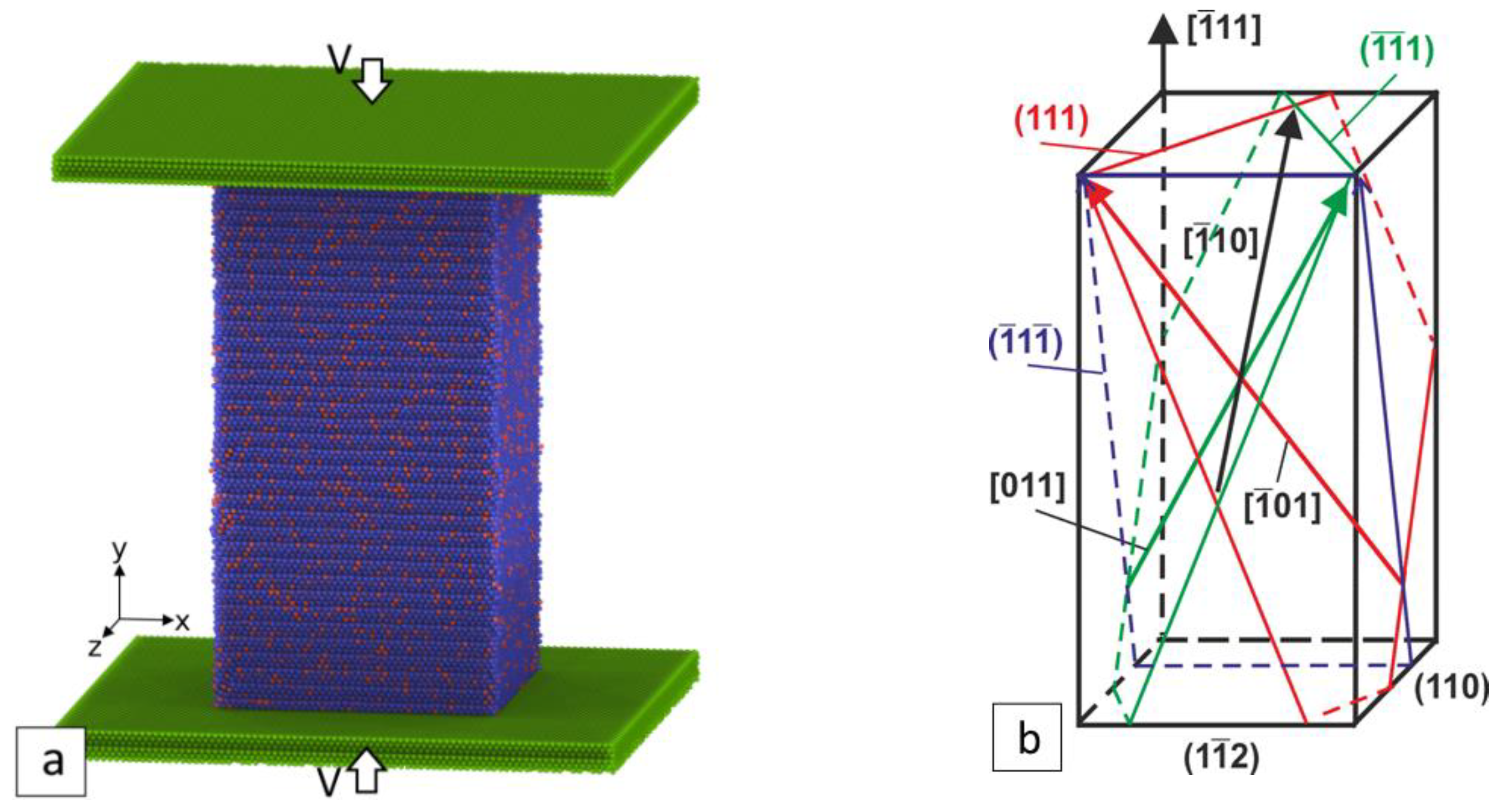
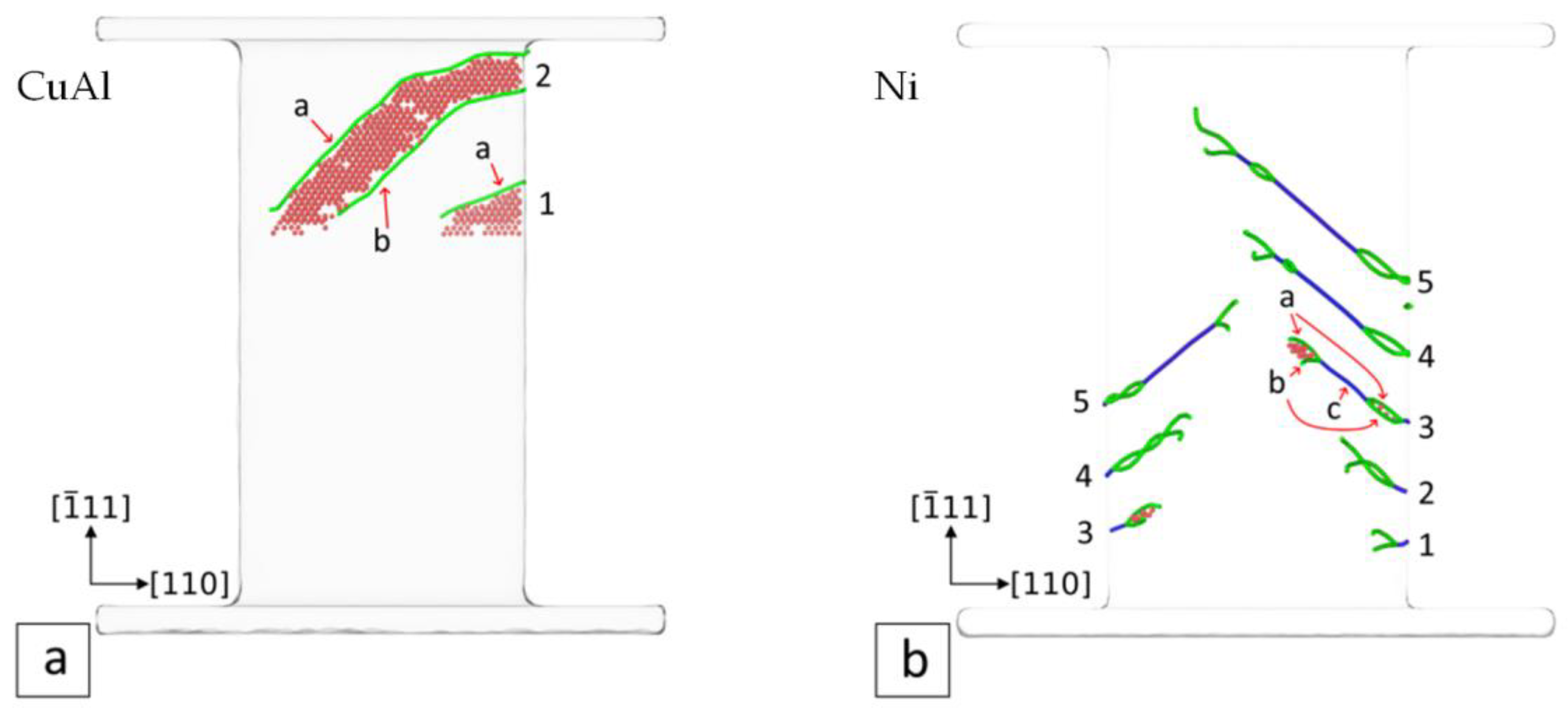
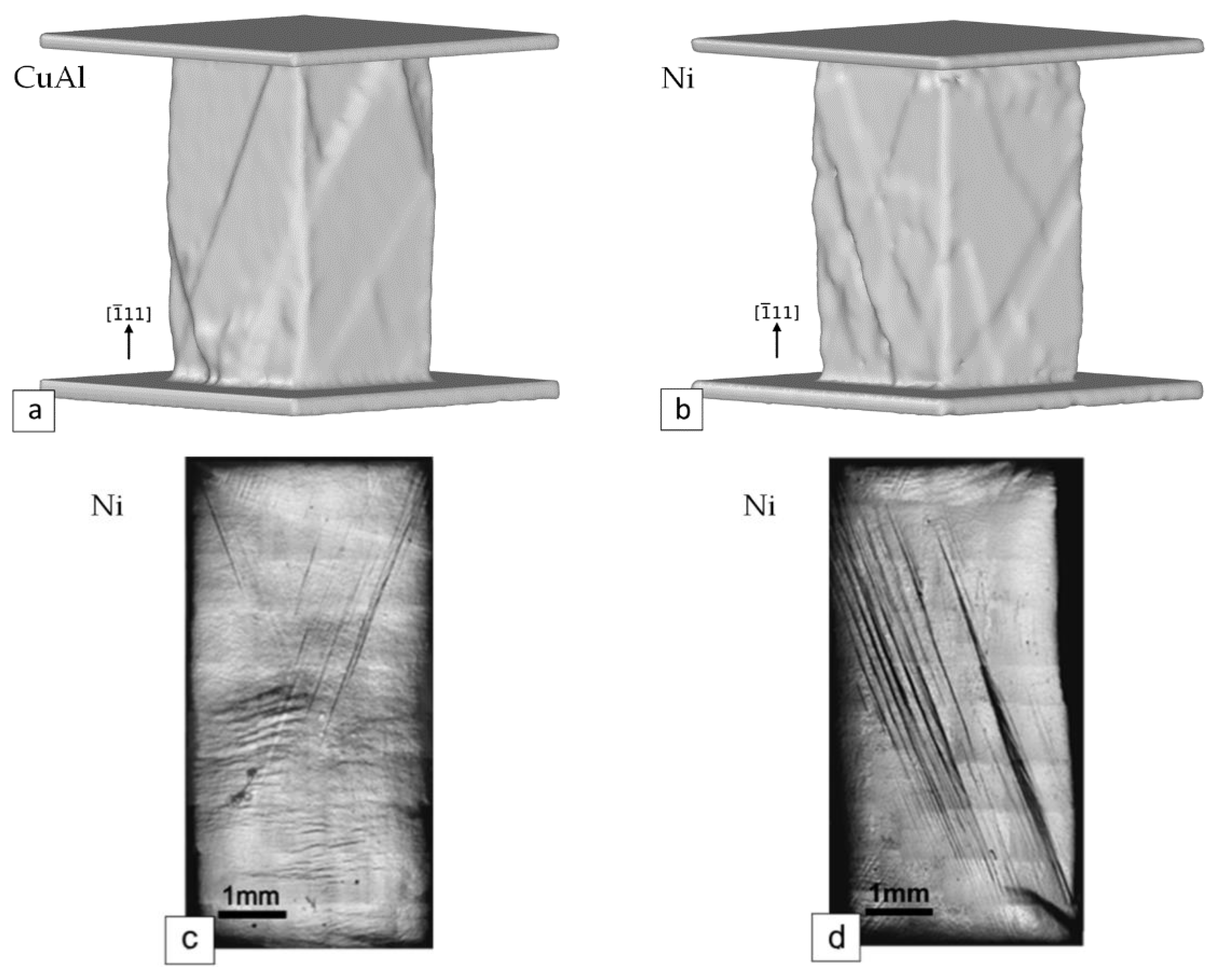
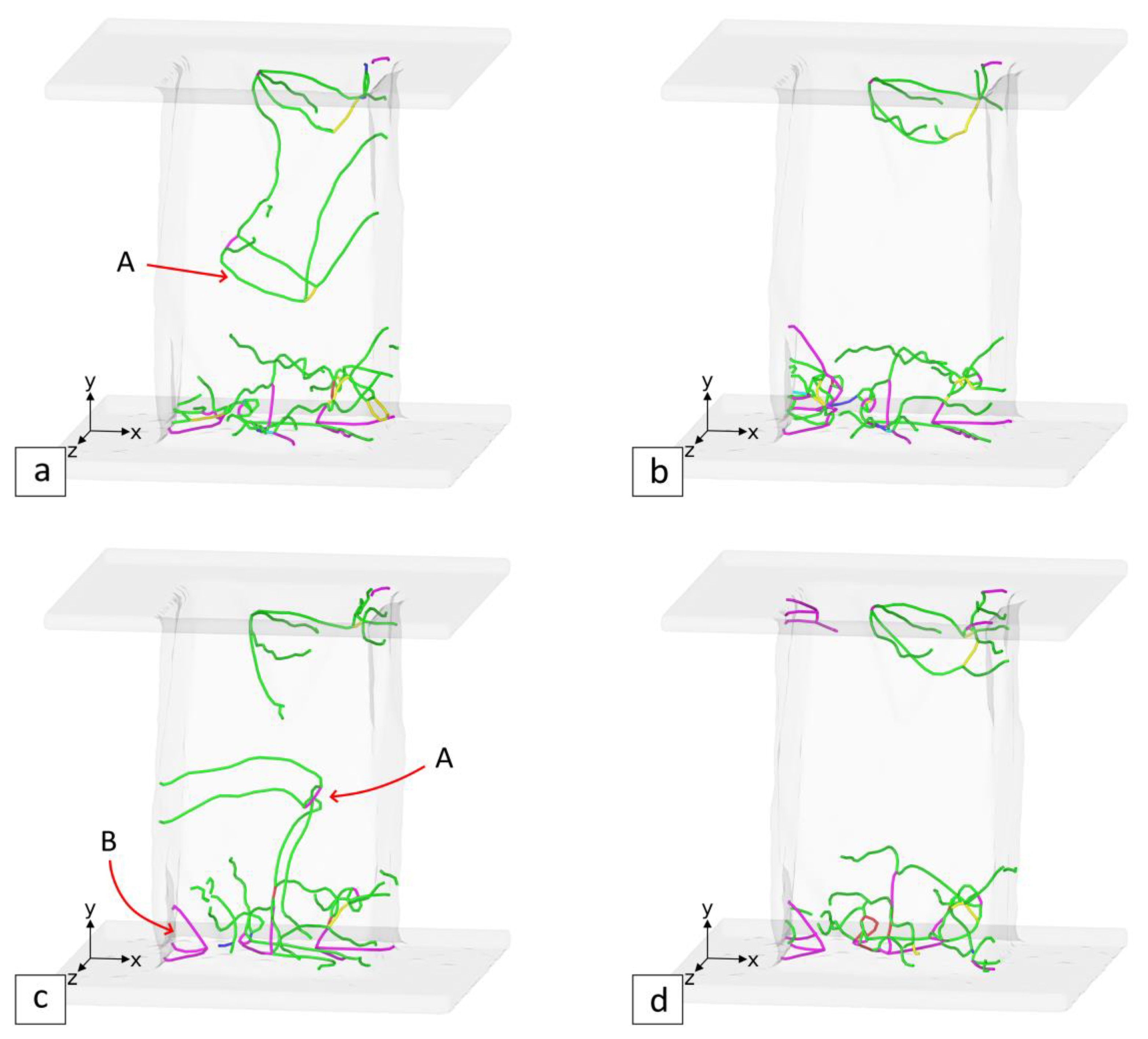
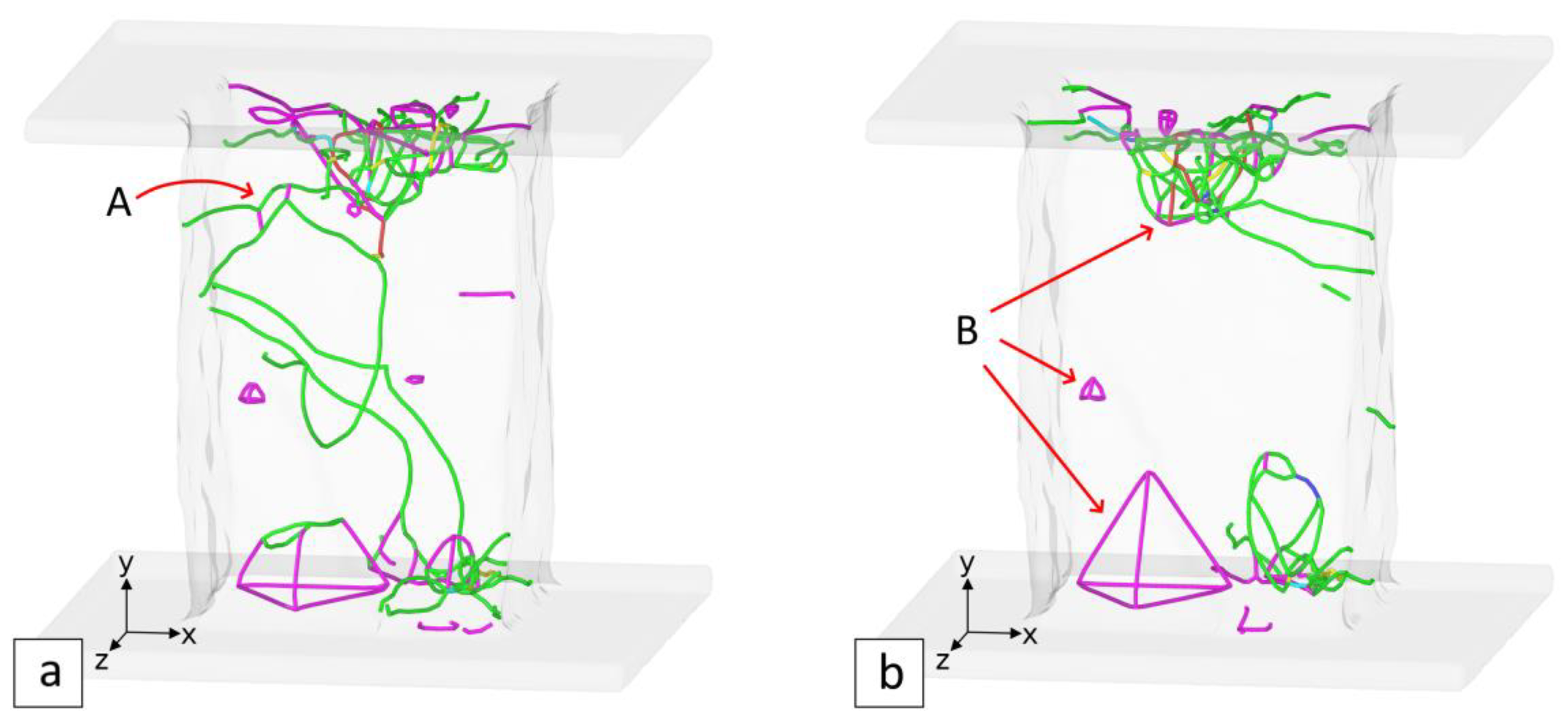
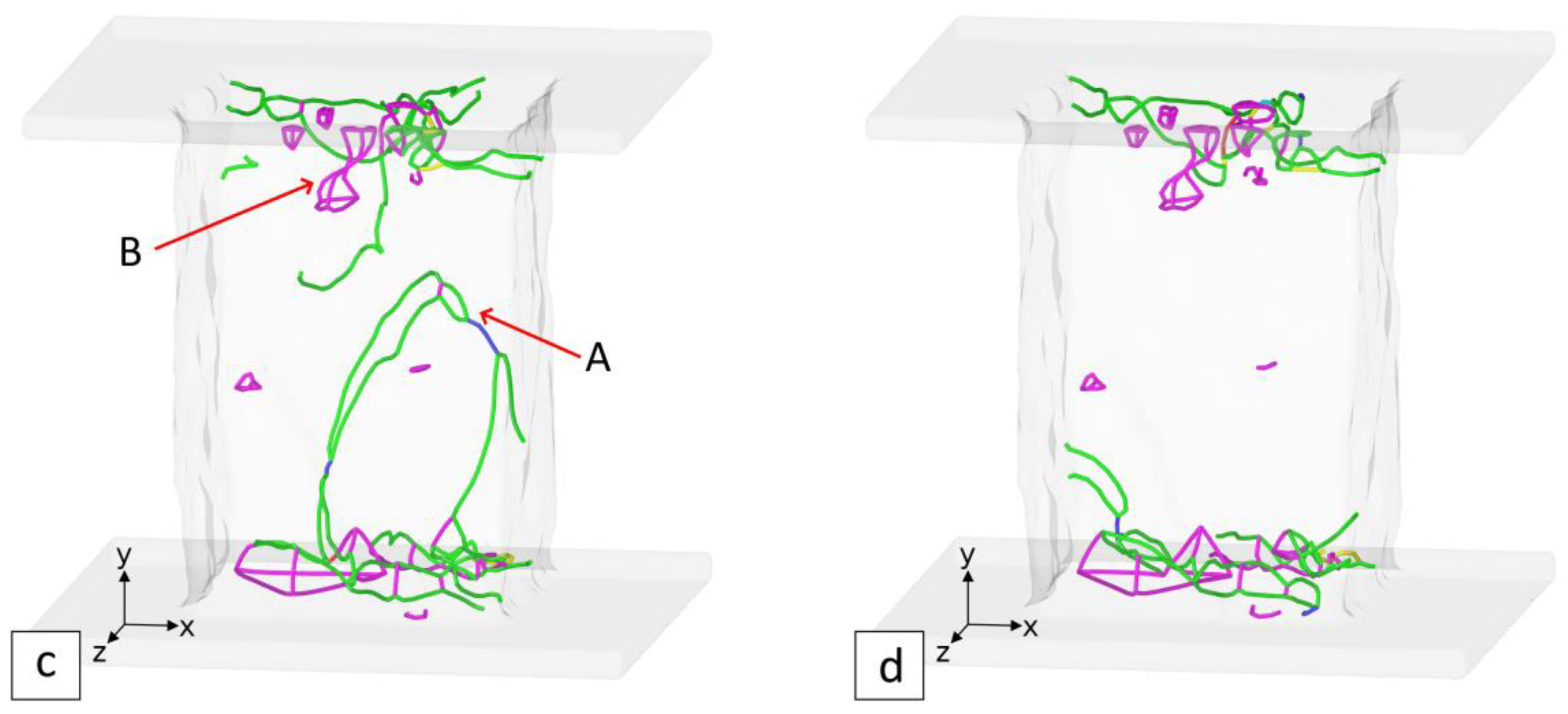
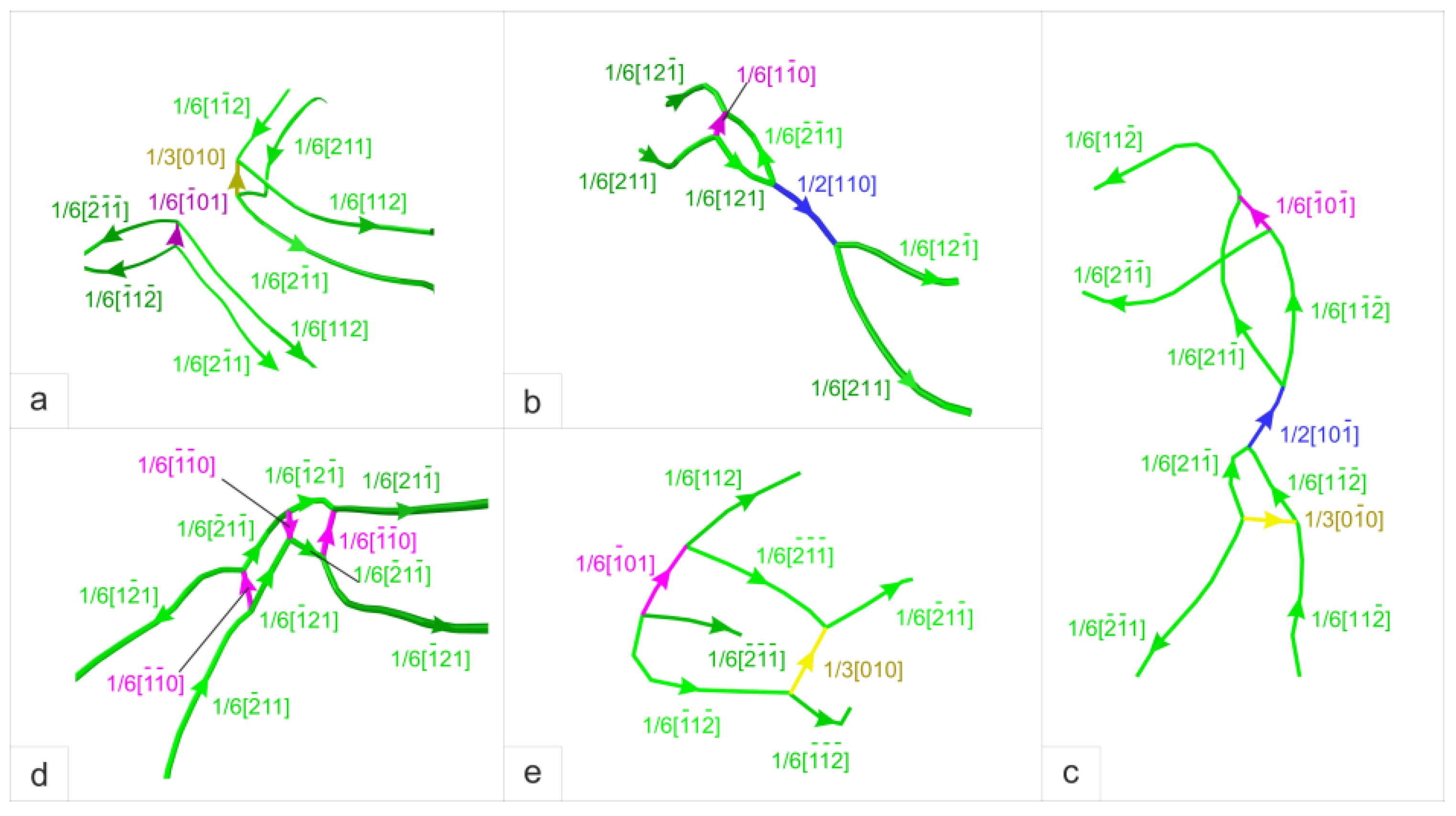
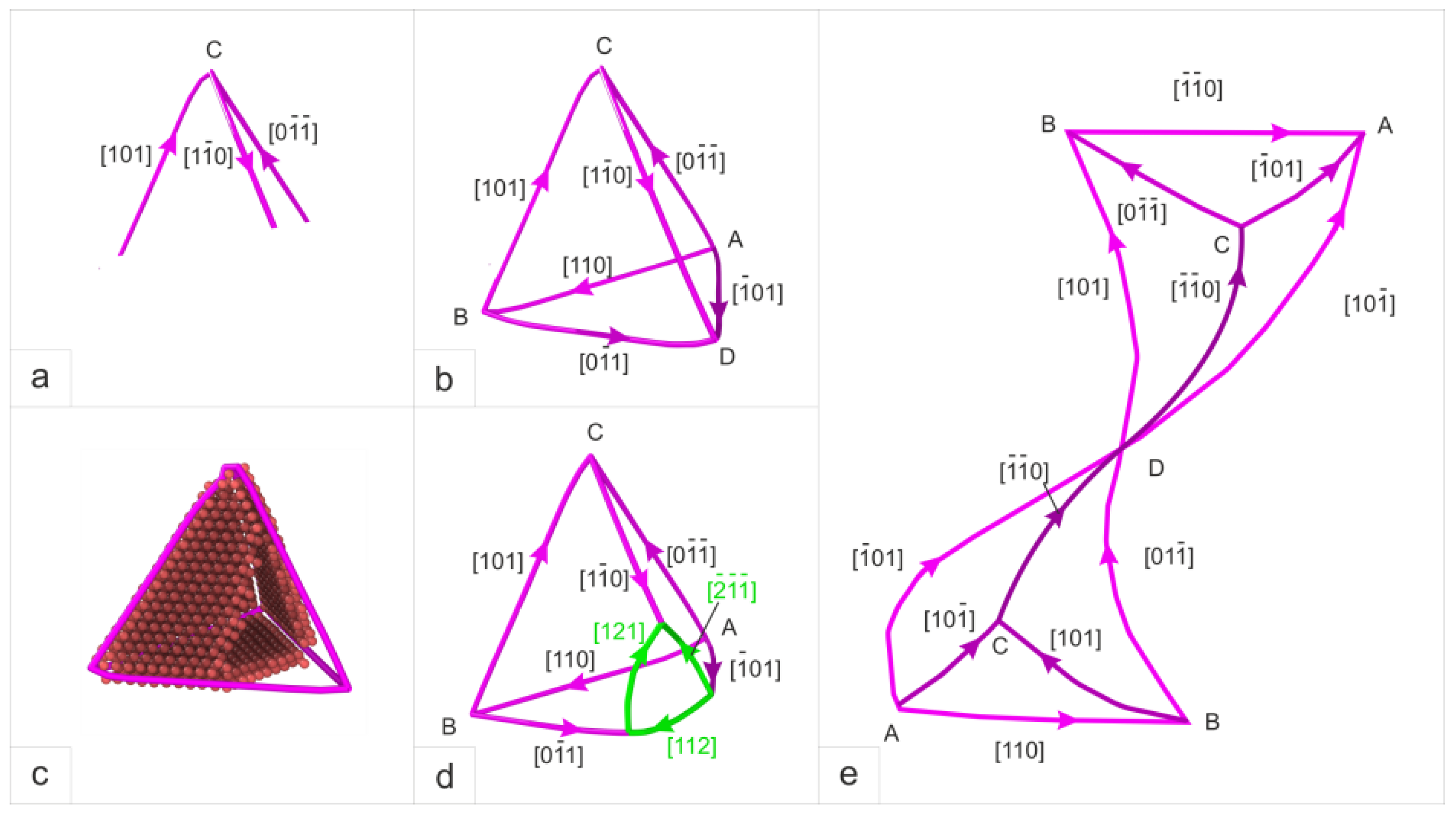
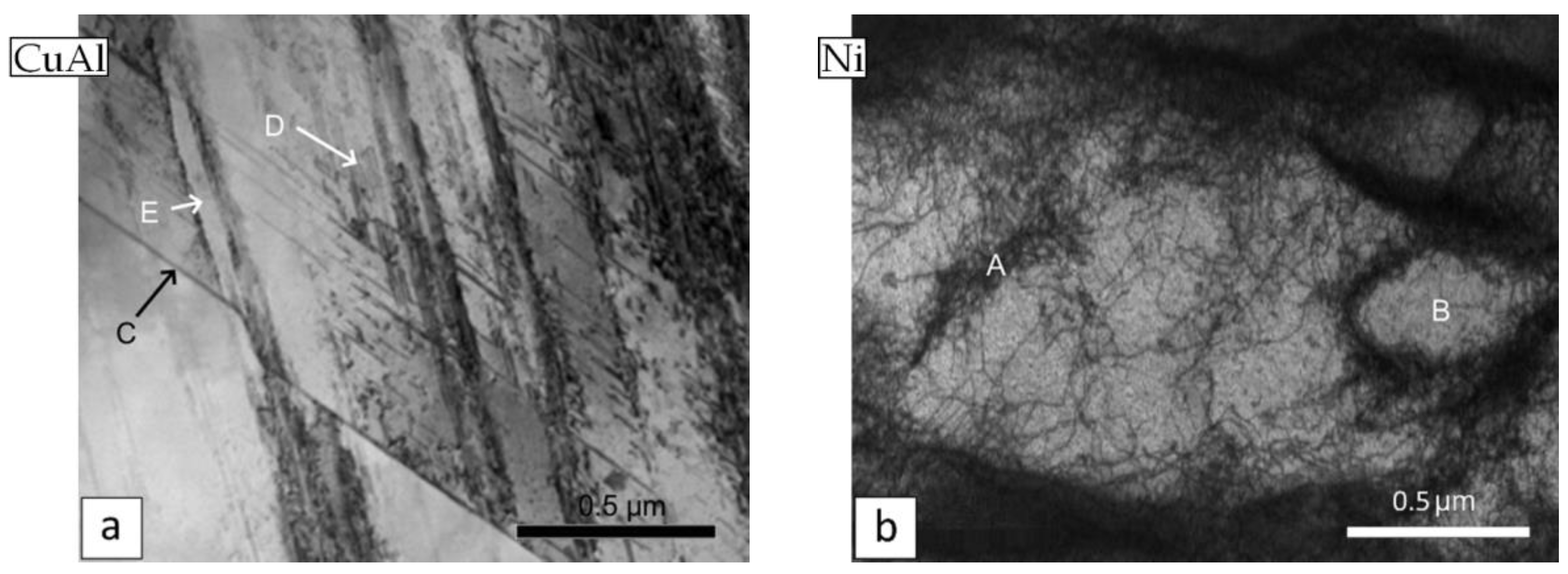
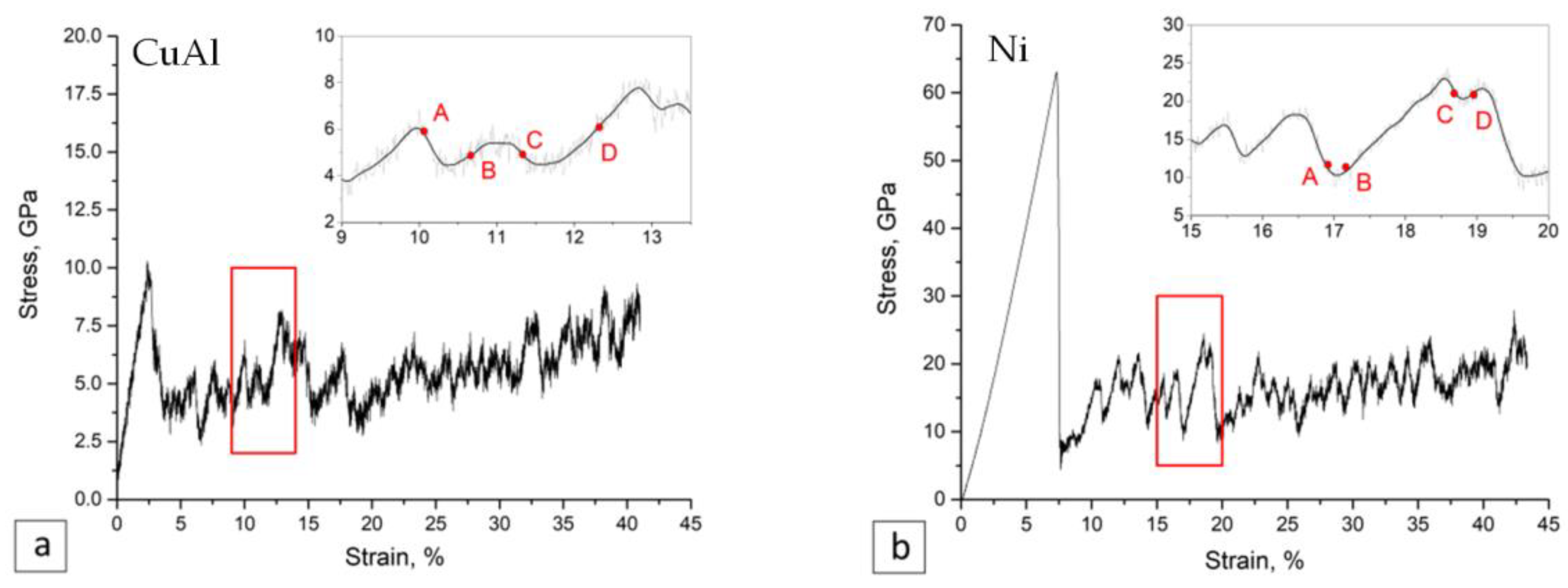
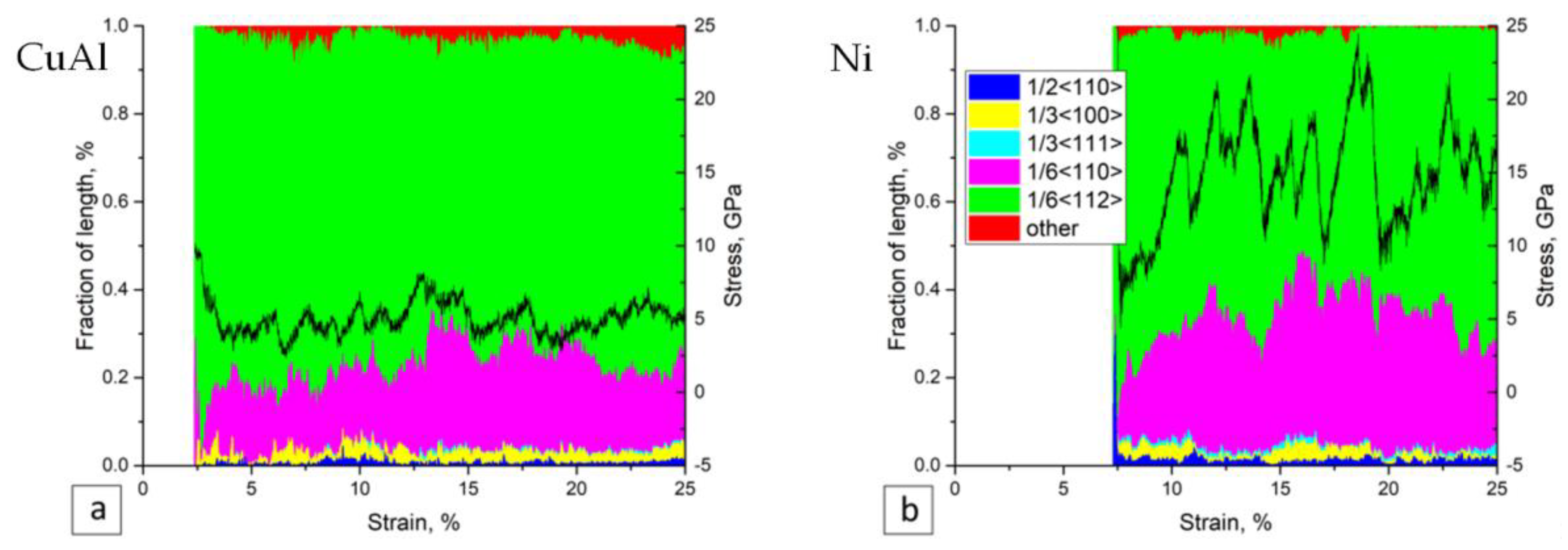
| Material | Simulation 300 K, mJ/m2 | Experiment, mJ/m2 |
|---|---|---|
| Ni | 136 | 150 |
| Cu-13at.%Al | 17 | 3 |
Publisher’s Note: MDPI stays neutral with regard to jurisdictional claims in published maps and institutional affiliations. |
© 2021 by the authors. Licensee MDPI, Basel, Switzerland. This article is an open access article distributed under the terms and conditions of the Creative Commons Attribution (CC BY) license (https://creativecommons.org/licenses/by/4.0/).
Share and Cite
Nikonov, A.Y.; Dmitriev, A.I.; Lychagin, D.V.; Lychagina, L.L.; Bibko, A.A.; Novitskaya, O.S. Numerical Study and Experimental Validation of Deformation of <111> FCC CuAl Single Crystal Obtained by Additive Manufacturing. Metals 2021, 11, 582. https://doi.org/10.3390/met11040582
Nikonov AY, Dmitriev AI, Lychagin DV, Lychagina LL, Bibko AA, Novitskaya OS. Numerical Study and Experimental Validation of Deformation of <111> FCC CuAl Single Crystal Obtained by Additive Manufacturing. Metals. 2021; 11(4):582. https://doi.org/10.3390/met11040582
Chicago/Turabian StyleNikonov, Anton Y., Andrey I. Dmitriev, Dmitry V. Lychagin, Lilia L. Lychagina, Artem A. Bibko, and Olga S. Novitskaya. 2021. "Numerical Study and Experimental Validation of Deformation of <111> FCC CuAl Single Crystal Obtained by Additive Manufacturing" Metals 11, no. 4: 582. https://doi.org/10.3390/met11040582
APA StyleNikonov, A. Y., Dmitriev, A. I., Lychagin, D. V., Lychagina, L. L., Bibko, A. A., & Novitskaya, O. S. (2021). Numerical Study and Experimental Validation of Deformation of <111> FCC CuAl Single Crystal Obtained by Additive Manufacturing. Metals, 11(4), 582. https://doi.org/10.3390/met11040582







